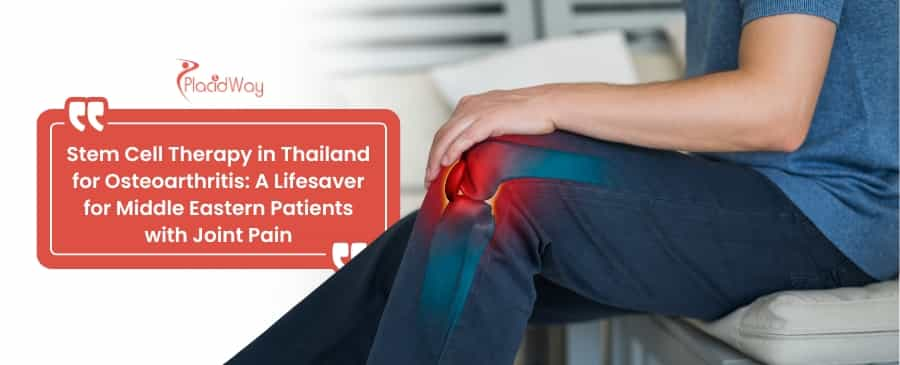
Key Takeaways
-
Significant Savings: Patients, particularly from the Middle East, can save up to 70% on stem cell therapy for osteoarthritis in Thailand compared to costs in the USA or UK.
-
Holistic Care Packages: Thai medical centers offer all-inclusive packages that often include the procedure, doctor's fees, accommodation, airport transfers, and sometimes translation services, ensuring a seamless experience for medical tourists.
-
Advanced Technology & Expertise: Thailand is home to internationally accredited hospitals with cutting-edge stem cell labs and experienced specialists, making it a leading destination for regenerative medicine.
-
Cost Comparison:
-
Thailand: Stem cell therapy for one joint (like the knee) ranges from $8,000 to $15,000.
-
Mexico: Similar procedures can cost between $7,000 and $14,000.
-
USA: The cost for the same treatment can soar to $20,000 - $30,000 or more.
-
Turkey: Prices are competitive, often ranging from $6,000 to $12,000.
-
What is Stem Cell Therapy for Osteoarthritis?
Stem cell therapy is a groundbreaking regenerative treatment that uses the body's own healing mechanisms to repair damaged cartilage in joints affected by osteoarthritis. This minimally invasive procedure aims to reduce pain, improve mobility, and potentially delay or eliminate the need for joint replacement surgery.
Osteoarthritis (OA) is a degenerative disease where the protective cartilage that cushions the ends of your bones wears down over time. This leads to pain, stiffness, and reduced function, most commonly in the knees, hips, hands, and spine. Traditional treatments like pain medication and physical therapy manage symptoms, but they don't repair the underlying damage.
Regenerative medicine, specifically stem cell therapy, offers a new approach. Stem cells are unique cells with the ability to develop into many different cell types. When injected into an arthritic joint, they can:
-
Differentiate into new cartilage cells (chondrocytes).
-
Release powerful anti-inflammatory proteins that reduce pain and swelling.
-
Secrete growth factors that stimulate your body's existing cells to begin a natural repair process.
-
Prevent further cartilage degradation, slowing the progression of the disease.
The most common type used for OA is mesenchymal stem cells (MSCs), which are typically harvested from the patient's own fat tissue (adipose-derived) or bone marrow.
Why Choose Thailand for Stem Cell Therapy?
Thailand has become a global hub for medical tourism by combining world-class medical standards, state-of-the-art technology, and affordable costs. For Middle Eastern patients, the country also offers a welcoming culture, excellent hospitality, and amenities like halal food and prayer facilities.
Choosing a destination for medical care is a significant decision. Thailand stands out as a top choice for stem cell treatment for joints for several key reasons:
-
Internationally Accredited Hospitals: Many Thai hospitals, such as those in Bangkok and Phuket, have JCI (Joint Commission International) accreditation, which is the gold standard in global healthcare.
-
Experienced Specialists: The country boasts a pool of highly skilled orthopedic surgeons and regenerative medicine specialists who are often trained in the US, UK, or Europe.
-
Advanced Stem Cell Labs: Reputable clinics in Thailand have sophisticated, in-house laboratories to process and prepare high-quality, viable stem cells for treatment, ensuring safety and efficacy.
-
Significant Cost Savings: The cost of stem cell knee injections in Thailand is a fraction of what you would pay in Western countries, without compromising on quality.
-
Cultural Sensitivity for Middle Eastern Patients: Thailand is well-equipped to cater to international patients. You'll find Arabic-speaking staff, halal-certified food options in hospitals and restaurants, and prayer facilities readily available.
-
A Healing Environment: The serene, beautiful environment of Thailand provides a perfect backdrop for recovery, allowing patients to combine top-tier medical care with a restful holiday.
Did You Know?
Bangkok is consistently ranked as one of the most visited cities in the world. Its advanced medical infrastructure plays a huge role, with over 60 JCI-accredited medical facilities—more than any other city in Southeast Asia. This makes it a powerhouse for medical tourism in Thailand.
The Stem Cell Therapy Procedure: What to Expect
The procedure is typically a same-day, minimally invasive process that involves three main steps: harvesting the stem cells, concentrating them in a lab, and injecting them into the affected joint. The entire process usually takes just a few hours, with minimal downtime required.
Understanding the treatment journey can help ease any concerns. While the exact protocol can vary slightly between clinics, a typical stem cell therapy for knee osteoarthritis follows this pathway:
Step 1: Consultation and Assessment
Your journey begins with a thorough evaluation by an orthopedic specialist. This includes:
-
A review of your medical history.
-
A physical examination of the affected joint.
-
Imaging tests like X-rays or an MRI to assess the extent of cartilage damage.
-
Blood tests to ensure you are a suitable candidate.
Step 2: Stem Cell Harvesting
This is a minor surgical procedure performed under local anesthesia.
-
Adipose-Derived (Fat): A small amount of fat is removed, usually from the abdomen or thigh, through a process similar to mini-liposuction. This is often preferred as fat tissue is an incredibly rich source of MSCs.
-
Bone Marrow-Derived: A needle is used to draw bone marrow from the back of the hip bone (iliac crest).
Step 3: Cell Processing and Concentration
The harvested tissue is taken to an on-site laboratory. Using a special device called a centrifuge, the stem cells are separated and concentrated to create a powerful, pure injectate. This critical step takes 1-2 hours.
Step 4: Injection into the Joint
The final step is the injection itself.
-
The specialist will clean the injection site (e.g., your knee).
-
Using ultrasound or fluoroscopy for precise guidance, the concentrated stem cells are carefully injected directly into the joint capsule where the cartilage is damaged.
-
The injection site is then bandaged. The entire injection process takes about 20-30 minutes.
Patients can typically return to their hotel the same day.
Cost of Stem Cell Therapy in Thailand for Osteoarthritis
The cost of stem cell therapy in Thailand for a single joint typically ranges from $8,000 to $15,000 USD. This comprehensive price is significantly lower than in the US or Europe and often includes services tailored for international patients, providing exceptional value.
One of the primary drivers for choosing medical tourism in Thailand is the affordable cost of high-quality care. The final price can depend on several factors, including the source of the stem cells, the number of joints being treated, the hospital's reputation, and the specific technology used.
Here is a comparative breakdown of the estimated costs for stem cell therapy for a single large joint (like the knee):
| Country | Average Cost Range (USD) | What's Typically Included |
| Thailand | $8,000 - $15,000 | Procedure, doctor fees, anesthesia, lab processing, pre-op tests, airport transfer |
| Mexico | $7,000 - $14,000 | Procedure fees, doctor consultation, some medications |
| Turkey | $6,000 - $12,000 | Procedure, hospital stay, sometimes includes hotel and transfers |
| USA | $20,000 - $30,000+ | Procedure fees only; consultations, imaging, and follow-ups are often extra |
| UK | $15,000 - $25,000+ | Procedure fees only; additional costs for diagnostics and consultations |
Expert Insight
"When evaluating cost, patients should look beyond the price tag of the procedure itself. Thai hospitals excel at creating all-inclusive packages. These bundles often cover accommodation, dedicated translators, and post-procedure check-ups, eliminating hidden costs and simplifying the entire medical journey for patients from the Middle East." - A regenerative Medicine Specialist, Bangkok.
Are You a Good Candidate for Stem Cell Therapy?
Ideal candidates are generally those in the early to moderate stages of osteoarthritis who are seeking an alternative to major surgery. A thorough medical evaluation is necessary to determine if this regenerative treatment is the right option for your specific condition.
Stem cell therapy for joint pain is highly effective, but it's not suitable for everyone. A specialist will assess your case, but you may be a good candidate if you:
-
Have been diagnosed with mild to moderate osteoarthritis.
-
Experience chronic joint pain that has not responded to conservative treatments like physical therapy, steroid injections, or pain medications.
-
Wish to postpone or avoid major joint replacement surgery.
-
Are in good overall health with no active cancers, infections, or blood-borne diseases.
-
Have realistic expectations about the outcomes and understand that results can vary.
This therapy is generally less effective for severe, "bone-on-bone" osteoarthritis where there is no cartilage left to regenerate.
Benefits, Success Rates, and Recovery
The primary benefits of stem cell therapy are significant pain reduction, improved joint function, and a rapid recovery with minimal downtime. Success rates are high, with many studies showing over 80% of patients experiencing noticeable improvement within a few months.
Key Benefits
-
Pain Relief: Drastically reduces or eliminates chronic joint pain.
-
Improved Function: Increases range of motion and mobility, making daily activities easier.
-
Minimally Invasive: Avoids the risks, scarring, and long recovery associated with surgery.
-
Natural Healing: Uses your body's own cells to repair damage, reducing the risk of rejection or side effects.
-
Quick Recovery: Most patients resume normal, low-impact activities within a week or two.
Success Rates & Results
Clinical studies on stem cell therapy for knees and other joints have shown promising results. While outcomes vary based on the patient's age, severity of OA, and lifestyle, a majority of patients report a significant reduction in pain and improvement in function. Improvements are typically felt within 2-3 months as the stem cells work to repair the tissue.
Recovery Timeline
-
First 2-3 Days: Rest the joint and avoid strenuous activity. Some mild swelling or discomfort at the injection site is normal.
-
First 2 Weeks: Begin gentle range-of-motion exercises as recommended by your doctor. Avoid high-impact activities like running or jumping.
-
1-3 Months: Gradually increase activity levels. You may be prescribed physical therapy to strengthen the muscles around the joint and maximize results.
-
3-6 Months: Most patients experience the peak benefits of the therapy during this period.
Frequently Asked Questions (FAQ)
Is stem cell therapy for osteoarthritis safe?
Yes, when performed by qualified specialists in a reputable clinic, the procedure is very safe. Because it uses your own cells (autologous), the risk of rejection or allergic reaction is virtually eliminated. The main risks are minimal and similar to any joint injection, such as a small chance of infection or local pain at the harvest/injection sites.
How long do the effects of stem cell therapy last?
The results can be long-lasting, with many patients experiencing relief for several years. The therapy aims to repair tissue and slow disease progression, not just mask symptoms. The longevity of the results can be enhanced by maintaining a healthy weight and active lifestyle.
Is the stem cell procedure painful?
The harvesting and injection procedures are performed with local anesthesia, so discomfort is minimal. Patients may feel some pressure during the procedures, and there might be mild soreness in the treated joint and harvest area for a few days afterward, which is easily managed with over-the-counter pain relievers.
How many treatments will I need?
For most patients with mild to moderate osteoarthritis, a single treatment is sufficient to produce significant and lasting results. In more advanced cases, a second injection may be recommended after a year or more, depending on your response to the initial therapy.
Can stem cell therapy completely cure my osteoarthritis?
Currently, there is no "cure" for osteoarthritis. Stem cell therapy is a highly effective treatment that can repair damaged cartilage, significantly reduce pain, and improve function for years, but it does not reverse the underlying aging process. It is best viewed as a way to manage the disease and delay or avoid surgery.
Why are the stem cells taken from my own body?
Using your own cells, known as an autologous transplant, is the safest method. It ensures perfect compatibility and eliminates the risk of your immune system rejecting the cells. Fat and bone marrow are also the most accessible and richest sources of the specific mesenchymal stem cells (MSCs) needed for cartilage repair.
How to Connect with PlacidWay
Ready to explore a life free from joint pain? PlacidWay is your trusted partner in navigating your medical journey to Thailand. We connect you with the world's leading clinics for stem cell therapy and provide end-to-end support.
-
Get a FREE Quote: Compare personalized, all-inclusive packages from top-rated Thai hospitals.
-
Talk to a Specialist: We can arrange virtual consultations with experienced orthopedic doctors to discuss your case.
-
Hassle-Free Planning: Let us handle the logistics, from appointments and accommodations to translators and travel arrangements.
Take the first step towards recovery. Contact PlacidWay today to learn more about Stem Cell Therapy in Thailand!


-Package-in-India-by-Dr.-Pravin-Patel.jpg)








Share this listing